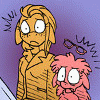
This is an idea I was kicking around for a mid to late WWII Allied era heavy/ fighter-ground attack aircraft. Part of the exercise was to develop a twin engine aircraft that reduces the issue of asymmetrical thrust in an engine out scenario, and reduces the cross section to make it a smaller target to groundfire and improved aerodynamics. One way is to put both engines on the centerline in a fashion like the Dornier 335.
Of course this does create its own problems which like Dornier 335 have to be accounted for. The biggest problem is you must provide some means of escape for the pilot. Just popping up the canopy and bailing out the side won't work; unless the pilot suddenly has an urge to pursue a new career as chunky salsa! You could try the trick of having an explosive charge that blows the back prop off , but that might not always work and the pilot still has to get out of the plane. The answer is an ejection seat which what Dornier decided on for the 335. Besides as speeds had increased throughout WWII it was becoming more an more apparent to designers that escaping from their aircraft was becoming almost impossible to do.
Also one must be certain that the rear prop does not start ingesting spent shell cases or blast exhaust from rocket launching under the wing. Also you would want to make certain that any centerline drop tanks or bombs don't bang the prop when you release it. Perhaps a compressed air system that pushes the shackles down quickly from the aircraft then release the tank or bomb. Kind of like some rail launchers do for AAMs on jets.
Of course this does create its own problems which like Dornier 335 have to be accounted for. The biggest problem is you must provide some means of escape for the pilot. Just popping up the canopy and bailing out the side won't work; unless the pilot suddenly has an urge to pursue a new career as chunky salsa! You could try the trick of having an explosive charge that blows the back prop off , but that might not always work and the pilot still has to get out of the plane. The answer is an ejection seat which what Dornier decided on for the 335. Besides as speeds had increased throughout WWII it was becoming more an more apparent to designers that escaping from their aircraft was becoming almost impossible to do.
Also one must be certain that the rear prop does not start ingesting spent shell cases or blast exhaust from rocket launching under the wing. Also you would want to make certain that any centerline drop tanks or bombs don't bang the prop when you release it. Perhaps a compressed air system that pushes the shackles down quickly from the aircraft then release the tank or bomb. Kind of like some rail launchers do for AAMs on jets.
Category All / All
Species Unspecified / Any
Size 838 x 956px
File Size 76 kB
Looks a little like the Shinden as well as the Do335.
http://en.wikipedia.org/wiki/Ky%C5%ABsh%C5%AB_J7W
Nice design. Though I'd prefer two big cannons over 6 machine guns.
http://en.wikipedia.org/wiki/Ky%C5%ABsh%C5%AB_J7W
Nice design. Though I'd prefer two big cannons over 6 machine guns.
Well I imagining one large caliber cannon firing through a hollow propeller-shaft like the P-39 Aircobra and some models of the Me-109. Yeah I know they really didn't work out as well as there designers had hoped for, and ground crews and armorers generally hated them. But I could see some senior engineer with a passion for them pushing the idea through. "This time we'll make it work!" He says. "We know now what went wrong with the last design and this time we won't have that problem!" Two years later at some theater forward airbase a flight crew is standing on a flight line trying to figure out how to clear a jammed cannon without enough time to do the job by the book and still get the plane turned around for its next mission . One of them grumbles"Stupid engineers these things never work!"
i love this plane, its just like the D0 335 http://www.world-war-2-planes.com/do-335.html
i wish they saw more action in ww2, not alot of people know of it.
i wish they saw more action in ww2, not alot of people know of it.
I've always loved this designed, I heard the main reason it was turn down was appearance,
I hope you don't mind but I found this piece to show you...
http://www.youtube.com/watch?v=4MEmHDvK9Sk
I hope you don't mind but I found this piece to show you...
http://www.youtube.com/watch?v=4MEmHDvK9Sk
Looks like it solves many of the problems the american prototype single engine pusher fighter plane had. I forget the designation, but it had a similar layout to the shinden, and in the same timeframe, but chunkier looking and underpowered. It would have really been spectacular with the experimental Rolls-Royce Griffon engine shoehorned in the back. but with this layout, two allisons would have been fantastic like they were for the P-38 in its configuration.
I think you're thinking of the XP-55 'Ascender'
http://rides.webshots.com/photo/226.....58533133ydjhbp
http://rides.webshots.com/photo/226.....58533133ydjhbp
With all push-pull designs, the biggest technical hurdle will be cooling the rear engine. On all the German tandem-drive and push-pull designs there were always problems with cooling the rear engine, leading to overheat shutdowns and engine fires.Also kind of reminds me of the 'Mudfighter' concept suggested in a long-ago SoF article, about building a low-cost light attack aircraft well suited for counterinsurgency missions, using NASCAR-type racing engines for powerplants. While these do require a bit of skill to maintain, they're still easier to work on than most jet engines and the militaries the concept was aimed at would already have engine mechanics that could be relatively easily trained up to handle the differences.
Ah, but that would triple the frontal area. One pod for the pilot, one pod for each engine, means three big wads to shoot at.
Putting it all in one line means only a single wad to worry about. And in fact the thought experiment was just that; Putting it all on the centreline. Also means less trouble if one engine/prop goes pthbbt.
Putting it all in one line means only a single wad to worry about. And in fact the thought experiment was just that; Putting it all on the centreline. Also means less trouble if one engine/prop goes pthbbt.
I don't know if I'd want to thread that needle with my body. From what I've seen of film footage of bail-outs during WWII the pilots don't always drop clean back in a straight line. Sometimes they get thrown all over the place, especially if they can't jump clear in a neat fashion. P-38's were particularly bad about catch pilots on the elevator when they jumped. I even remember seeing reprint of a manual from the war showing that ideally the pilot should whenever possible invert the P-38 before bailing out. Nice advice but if you're jumping out of a plane it may not be all that controllable.
I personally think that the XP-55 would have worked if the engine was supercharged & intercooled,had a larger displacement and had two sets of counter-rotating props to increase thrust(simmilar to Houghs Spy Plane prototype or the Russian Tu-95 Bomber).Your design looks looks great! ^.^

 FA+
FA+





























Comments